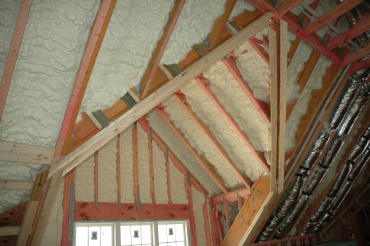
Steve Maxwell
Three spray foam myths – busted!
Canadian ContractorThese 3 main objections to using spray foam are all unfounded
 Good contractors steer their clients toward quality materials. This task requires diplomacy and tact and so it isn’t always easy, but it pays off. The better the projects you’re allowed to build, the happier your clients will be in the end. And happy clients are your ticket to future jobs that you don’t have to work as hard to find.
Good contractors steer their clients toward quality materials. This task requires diplomacy and tact and so it isn’t always easy, but it pays off. The better the projects you’re allowed to build, the happier your clients will be in the end. And happy clients are your ticket to future jobs that you don’t have to work as hard to find.
Quality builds require the best materials. It’s just as simple as that. This applies to everything from foundations to roofs. Spray foam is one specific case in point. It’s an example of how a safe, proven building technology can boost your reputation, despite being seen by some as a tougher, more costly option. Here are the three most common objections to spray foam, with logical reasons why fact should prevail over fear.
Spray Foam Objection#1: SAFETY
Fear is a powerful human motivator, but fear is often illogical. Somewhere in the collective unconscious of Canadian homeowners lurks 40-year-old memories of urea formaldehyde foam from back in the 1970s. More recently, news coverage that unfairly tarnishes the entire spray foam industry has re-awakened fears by delivering half-truths about some types of spray foam chemistry. So what are the facts?
First, there are many different spray foams on the market, so your clients need to understand that they’re not all the same. And second, the issue of safety usually comes down to something called the “blowing agent.” These are the elements in the foam responsible for making the raw components foam up during application, and differences in blowing agents are where safety fears can be most effectively addressed. Older blowing agents used to be associated with the “hole in the ozone layer.” This has been eliminated with the use of newer blowing agents.
There are a handful of different blowing agents used with spray foam, and this is where you need to inform yourself so you can inform clients. The first time I specified spray foam for a job was in 2005, and there were safety concerns from the owners. I specified a Canadian spray foam called Icynene (icynene.com; 800-758-7325) because it uses a water-based blowing agent, a far more environmentally sensitive and reliable option than synthetic blowing agents still used by some manufacturers. It’s also been verified free of long-term off-gassing by five different international safety organizations. That first spray foam job went well, a nasty condensation problem was solved, and success was achieved by explaining the truth about unfounded fears.
Spray Foam Objection#2: COST
Spray foam is the most expensive way to seal and insulate a building, and costs always concern people. Why would anyone want to pay 2x or 3x more money for the same R value of insulation as more traditional options? Keeping costs under control is important, but upfront costs are only part of owning a building.
Spray foam delivers more real-world energy performance for a given R value than any other option, and that’s the other side of the coin. So how does this play out in the real world? For an insulation product to perform, air infiltration must be controlled. This adds to the cost of installing most insulation materials. Spray foam provides insulation and air sealing at the same time, virtually assuring high performance. Roughly speaking, spray foam insulation can help reduce the heating and cooling costs of the average home by as much as 40 per cent. Actual performance varies, but this is a good ballpark figure to work with. Generally speaking, less than five years usually covers the payback period. Sometimes less. After that, all the energy saved turns into real gains.
“We generally find that projects our contractors spray have an average three to four year payback,” explains Betsy Cosper from Icynene. “Spray should be regarded less as an expense but rather an investment that pays back in savings year over year. And the higher overall energy costs get, the faster that investment pays back.”
Spray Foam Objection#3: TROUBLE
More and more clients are educating themselves online, and that’s both a blessing and a curse. It’s a good thing when you can talk to clients about sophisticated concepts they already understand, but bad when they’ve picked up partial truths online. Some internet myths suggest foam can pull away from framing members. This would fall into the category of a partial truth.
While it’s true that spray foam can sometimes shrink and leave gaps between studs, joists and plates, this hardly ever happens. Properly applied foam laid down by a trained and licensed professional won’t shrink, but to put your client’s minds at ease, I have seen builders leave foamed areas open for two weeks before covering it. If shrinking hasn’t happened by then, it won’t. And if gaps do open up, fill them with spray foam from a can.
Some drywallers hate foam because even a little too much means that drywall can’t sit flat against framing members. And unsupported drywall can cause nail pops and trouble. The reality, however, comes down to skill. Proper foam application is something that takes training and aptitude. Trained applicators understand the need to avoid overfilling, and proper jobs always include scraping excess foam off the bearing surface of framing members.
Advertisement
Print this page

Do you have a foam that will replace retro foam that was banned in Canada 2000. I was ready to get it installed when it was banned.